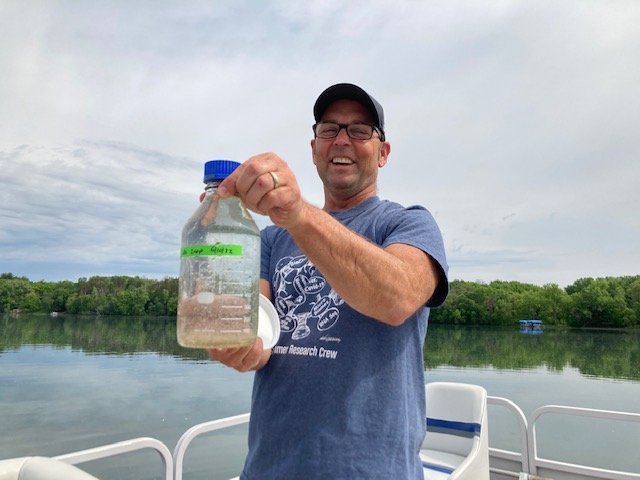Dr. Leif Hembre’s 2022 Daphnia Research Update
As many of you know, our esteemed friend Leif Hembre, Ph.D., is Professor of Biology, and Environmental Studies affiliate faculty member, at Hamline University in St. Paul.
Over the years, Dr. Hembre has conducted extensive research and published numerous, highly praised articles on the impact of Daphnia on Square Lake’s pristine water quality.
For those of you who are interested in the science of Square Lake’s critically important Daphnia population, here are links to two of Leif’s most recent studies:
Leif recently visited Square Lake with two of his Hamline students to conduct additional research. In his words, here is an update on new research that relates to the trout stocking moratorium study (originally reported in the Hembre, 2019 article).
Context for current research:
“Towards the end of field data collection for the monitoring study that we carried out (Hembre, 2019) to evaluate the effects of predation of stocked rainbow trout (RBT) in Square Lake on the lake's zooplankton community and its water quality (clarity, algae levels in surface water, oxygen levels in deep water, and total phosphorus levels in surface water), we worked with the LacCore Lab from the University of Minnesota to begin a paleoecological study of Square Lake and Big Carnelian Lake.
For this paleo study, we collected sediment cores from Square Lake and Big Carnelian Lake in the summer of 2015. The purpose for collecting these sediment cores was to gain a deeper understanding of ecological changes occurring over a longer time period in Square Lake than was examined for the 5-year monitoring study. By using this paleo approach, we are able to use biological remains and information about sediment composition to investigate changes occurring over many decades from before and after the initiation of the RBT stocking program in Square Lake in 1981.
We are primarily interested in changes in the zooplankton species composition and body sizes of Daphnia. We are able to assess that by extraction and microscopic examination of zooplankton remains (exoskeletal fragments & resting eggs) from different depths in the sediment cores (deeper sediments = older sediments). Our expectation is that through the examination of sediments of different age we would find that the abundance and size of the remains (a proxy for whole body size) of the large-bodied Daphnia species in Square Lake (D. pulicaria) would have decreased after the initiation of the RBT stocking program in 1981, while those changes would not be observed in remains in the sediments of Big Carnelian Lake. For this study, Big Carnelian Lake serves as a reference ecosystem ("control") to compare against findings from Square Lake. Big Carnelian was chosen to be the reference lake because it is located near Square Lake (and therefore has experienced the same climate over the years), has a relatively similar mean depth and water quality, and importantly, has never been stocked with RBT.
Our most interesting result thus far is that we have found evidence that the mean body size of individuals in the D. pulicaria population (determined from measurements of exoskeletal remains and resting egg cases) significantly decreased after 1981, while body sizes of individuals in the D. pulicaria in the Big Carnelian Lake population did not. This finding is consistent with our expectation, since RBT are known to be size-selective predators.
Another related project that I am working on with a student (Marcella Meneguzzi) is a "resurrection ecology" study that aims to evaluate evidence for evolutionary change in the D. pulicaria population of Square Lake by hatching ('resurrecting') Daphnia from their resting/dormant eggs (ephippia). The ephippia are extracted from the sediment core samples (of known age), and then the hatchlings are cultured in the lab to create multiple clonal offspring from the original hatchling. In this way, we can obtain replicate animals of the same genotypes from a range of sediment depths/ages to use in experiments to assess evidence for the evolution of life history traits that would enable better survival and reproduction in the face of higher levels of predation by RBT (e.g., evolution of smaller body size, earlier reproduction).
We are in the early days of this project, but we're really excited to find out what will happen. I've also attached a PDF with a couple of diagrams that give a sense of how this study will be carried out: Resurrection Ecology Study Slides.
There are many more details and findings that I could share at some later date. I appreciate the support of the Square Lake Association over the years.
Best,
Leif Hembre”
We are blessed to have a brilliant, internationally recognized, Biologist, educator, Daphnia subject-matter-expert, and friend, fully and generously committed to our collective mission to preserve and protect the Lake.
Our collective thanks to Leif, and his Hamline students, for their uniquely valuable Square Lake Daphnia research, analytical studies, and published scientific papers.

